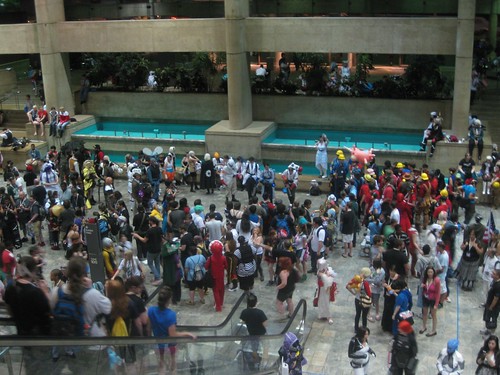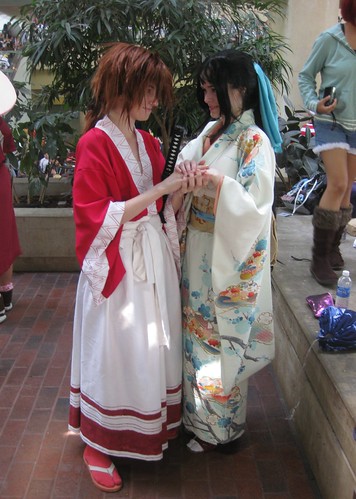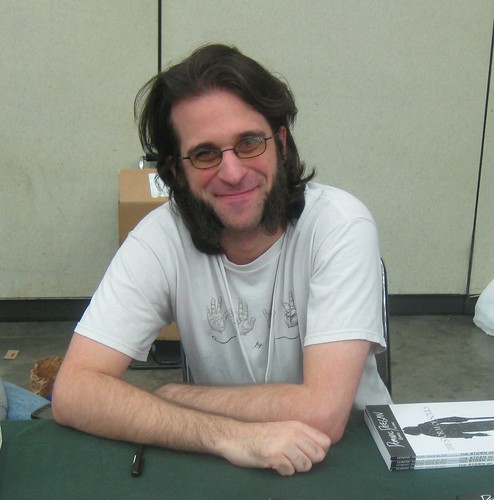Relating Science and Science-Fiction at Otakon
- By Jillian Brown
- August 20, 2012
- 1 Comment
During the last weekend of July Baltimore was host to about thirty-two thousand very interesting people (in addition to the devoted sports fans at Camden Yard and M&T Bank Stadium). Nerds, geeks, fans and enthusiasts alike gathered at the Baltimore Convention Center for Otakon 2012, the nineteenth-annual Baltimore convention devoted to the appreciation and epxerience of anime (Japanese animation), video games, comics, and artists. Thousands of attendees spent the months before the convention hard at work on their cosplay, costumes fashioned in the likenesses of their favorite characters from beloved series. Among the thousands of characters represented, Captain Jean Luc Picard, Sailor Moon, Static, the BBC’s Sherlock Holmes, and Batman were all in attendance. But whether they were the Onceler, the Thundercats or the Avengers, royalty or giant robots, all of these fans have in common the love for elements of science-fiction and fantasy incorporated into compelling stories and creative works as tools for storytelling, worldbuilding and imagination. Being a self-identified geek myself, someone who not only appreciates the inclusion of a degree of science in my science-fiction stories of choice but is interested in hearing how my fellow enthusiasts relate to science, and how science-fiction can function as a bridge to the sciences, while I was at Otakon I interviewed a selection of the attendees to get their thoughts. We talked about science in their sci-fi, their experiences with science, things they noticed about the portrayal of scientists in pop culture, cool things in space, and some of the exciting stuff that NASA is up to right now.

Congoers crowd one of the open areas at Otakon for photoshoots and event programming, many of whom are in cosplay (including the series Team Fortress 2, Portal, Tiger and Bunny, Phoenix Wright, Sailor Moon, Homestuck, Mass Effect, Okami, The Avengers, and more)
Credit: Jillian Brown
Most of the people I talked to expressed a preference for at least a moderate amount of science in their sci-fi programming, whether the “science” was demonstrating true-to-life methods of data collection and analysis in crime dramas, the occasional factual tidbit to make something incredulous a bit more believable, or the lack of raucous noise from explosions in space (there’s no sound in space, remember!). At the same time though, there’s also a wariness of too much hard science being tossed around. Too much attention to the minutiae or detail to the point of pedantism can turn off an audience from remaining interested and invested in the story being told. For the people I spoke to, who were of all ages and walks of life, who were passive readers and fanworks writers and original content creators, science-fiction stories capture not just the wonder of science but the mystery of the worlds in which those stories are set to create a compelling narrative, and inattention to either can send a story careening off balance. Most sci-fi fans find it very important for creators to strike the right chord between those two feelings, and while suspension of disbelief is different things to different people, generally speaking at least a little exposition is considered good form. Both fans and creators believe that science-fiction stories should flow logically, with the included science flowing smoothly to contribute to the plot rather than distract from it.
As a geek myself it made me really happy to see other people getting excited about science (and astronomy in particular, but that’s my bias showing). Just as physics, geology and genetics capture the imaginations of scientists everywhere and drive them to investigation and outreach, they motivate sci-fi fans to think about how their most cherished characters and fictional worlds relate to ours, how they compare, and how the collective body of human understanding applies to their fandoms. It turns out that for a lot of people, science-fiction becomes a bridge to learning more on their own about the world around us, where the enthusiasm for the stories meets the desire to connect with both fictional and real worlds at the same time. How many engineers got their start looking up to Gene Roddenberry’s Montgomery “Scotty” Scott while watching Star Trek: The Original Series? Are there future physicists out there who are right now following Chell through Portal 2, or being inspired to write stories by the Higgs boson? Everyone I spoke to said that their interest in scientific disciplines was often sparked by an introduction to the field in a geek setting: like a Half-Life fan getting into physics, or a reader of Aldous Huxley’s Brave New World or Scott Westerfield’s Uglies series wanting to know more about the current understanding of genetics. Through their series of choice, the fans I spoke to have gone out of their way to look into things that they might not otherwise have been so eager to learn more about, with entertainment media as their catalyst. Interestingly, sometimes this can lead to discovering key concepts that the series got horribly wrong! Fans expressed disappointment at writing that represents the scientific world poorly, or just plain incorrectly. They’re also often disappointed in depictions of scientists and analytically-minded people as having a borderline obsessive drive for their work or research (often to the exclusion of food and hygiene). The sinister mad scientist and the bungling antisocial researcher tropes are usually seen as very distasteful unless played for laughs, and from that we can draw reassuring conclusions about how geeks think of real-world scientists.

Attendees derpderpmothers and simplesignifier, two of the interviewed congoers, cosplayed Himura Kenshin and Kamiya Kaoru from Rurouni Kenshin on Saturday morning of Otakon.
Credit: Jillian Brown
“Geeky” people are just as creative and imaginative as the creators and scientists they admire (the same can of course be said about all people, not just the nerdy ones). Fans are often creators themselves, be it of fan-art or fan-fiction (both works inspired by or based on existing fiction), original art and stories, novels, scripts, or tabletop roleplaying game sessions. I spoke to Michael “Mookie” Terracciano, who goes to conventions like Otakon to promote his popular webcomic Dominic Deegan: Oracle for Hire, which recently celebrated its tenth year of daily updates. Though he considers Dominic Deegan to be more a work of science-fantasy than science-fiction, Terracciano – who dabbles in amateur astronomy as a hobby – recognizes the appeal of blending some science into his writing for the story. In his words, “science has a lot of wonder,” a wonder that he captures in the comic: in the most recent story arc for instance, the ‘Heart of Magic,’ the source of all magical power in the world, was revealed to orbit the planet’s parent star distantly. Much like how the gravity exerted by objects in orbit upon each other differs as they move away from each other, as it travels the Heart of Magic’s effects on a given planet change over time. The precise orbital period of the Heart of Magic or the exact index of magical energy transfer don’t have to be discussed for the story to stay compelling, and excluding them doesn’t hurt the development of the plot in any way. It’s this sort of middle ground between the two extremes of gratuitous science-fact-dumping and keeping everything ever mentioned mystical and unexplained that many sci-fi enthusiasts prefer to see in their content.

Writer and artist Michael “Mookie” Terracciano at his table in the Artists Alley at Otakon
Credit: Jillian Brown
I had lots of questions for my nerdy cohorts, but I was particularly interested in their take on what sci-fi says about our thoughts on the future. As large of an umbrella term as “science fiction” is, it can be difficult to make generalizations about the genre as a whole. But I had to know; if they absolutely had to think of it that way, how do people feel about sci-fi? Is it a reflection of our hope for the future, imaginings of what achievements and accomplishments might lie ahead, or is it playing pretend with impossibilities that just make good entertainment? Naturally, the oft-explored dystopian societies that populate a lot of sci-fi content came up frequently, as they often feature a great deal of advancement in tech but are simultaneously pretty bleak by most counts – at least, as their stories begin. A number of the fans I talked with mused over the merits of a “hopeful” dystopia; does it really count as something that looks toward a better future if, from our perspective, that future is in shambles? Many of them are intended as cautionary tales, to remind us of whatever danger the creator thinks could lead humanity astray, so some dystopian worlds are downright depressing. Still, dystopias explore how humanity copes with and lives in a changed world. While that new world may not be a bright and cheerful one, they often include technological advancements that enable greater capabilities than currently available(whether or not the technology is responsible for the dystopian conditions itself). Considering that one of the basic premises of science-fiction is exploring how people might act and live in different environments and under different circumstances, dystopias fit well within this framework while not being expressly “hopeful” for the future. The attending geeks I rounded up over the course of the weekend were almost all of the opinion that science-fiction is inherently aspirational. screamingwinchesters said to me that sci-fi is “humankind reaching out to what they wish they could do,” and generally people seem to agree.
Lots of my interviewees were excited about Curiosity‘s time on Mars, and in a way the Curiosity landing is itself a manifestation of science-fiction’s principles. With descent-phase rockets powering the sky crane that lowered the rover to the surface, it represents a feat of engineering that would have been literally impossible from the perspective of historical science-fiction greats like Wells, Heinlein, and Asimov. The landing captured the world’s attention (and a temporarily overwhelming chunk of NASA’s bandwidth), and that excitement doesn’t have to go away. Even within a single lifetime NASA and other space agencies have brought astronomy, physics, geology, cosmology and the search for extant life elsewhere in the universe to levels of accomplishment previously found only in the human imagination. If sci-fi’s fans are any indication, it hopes for even more. As we expand our understanding of how the universe works the ideas we incorporate into fiction change and grow. Scientific and technological innovation and works of science fiction fuel each other in a mutually-beneficial way, both drawing influence and inspiration from the other. Because of this special bond we have touchscreens and powerful portable devices that enrich the ways in which we learn and life, and to geeks like me, the world wouldn’t be the same without it.
Special thanks to Michael “Mookie” Terracciano, Jeff Sweeney, derpderpmothers, simplesignifier,screamingwinchesters, space-pirates, numinousmotorcycles, queenechidna, mstaury, and zombiegraycat.



Very interesting post Jillian. I didn’t know NASA was big on anime and science fiction.